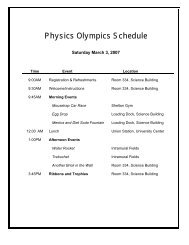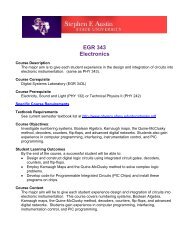Introduction to Engineering/Physics PHY 108.002 Syllabus â Fall 2011
Introduction to Engineering/Physics PHY 108.002 Syllabus â Fall 2011
Introduction to Engineering/Physics PHY 108.002 Syllabus â Fall 2011
You also want an ePaper? Increase the reach of your titles
YUMPU automatically turns print PDFs into web optimized ePapers that Google loves.
<strong>Introduction</strong> <strong>to</strong> <strong>Engineering</strong>/<strong>Physics</strong><br />
<strong>PHY</strong> <strong>108.002</strong> <strong>Syllabus</strong> – <strong>Fall</strong> <strong>2011</strong><br />
Instruc<strong>to</strong>r: Dr. Harry D. Downing, Professor of <strong>Physics</strong>, Department of <strong>Physics</strong> and Astronomy<br />
Office: Room 322B Miller Science Building<br />
Office Hours: 10:30-11:30 MWF; 11:00-11:50 TR; 2:30-3:30 MW, or by appointment<br />
Phone, Fax, E-mail: 468-2290 or 468-3001, Fax: 468-4448, hdowning@sfasu.edu<br />
Class Meeting Times and Place: 2:00-3:50 TR, Room 323 Miller Science Building<br />
<strong>Physics</strong> Homepage: www.physics.sfasu.edu<br />
Course Home Page: http://www.physics.sfasu.edu/downing/108HomePage.htm<br />
Text and Materials: College <strong>Physics</strong> 10 th ed (Schaum's Outline, Authors: Frederick J. Bueche and Eugene<br />
Hecht)<br />
COURSE DESCRIPTION<br />
3 semester hours, 2 hours lecture and 2 hours recitation per week. Introduc<strong>to</strong>ry course on<br />
engineering/physics analysis with practice in analyzing and solving problems in physics and engineering.<br />
Includes use of computational devices and methods.<br />
PROGRAM LEARNING OUTCOMES<br />
There are no specific program learning outcomes for the physics program addressed in this course.<br />
GENERAL EDUCATION CORE CURRICULUM OBJECTIVES/OUTCOMES<br />
This course is not included in the general education core curriculum.<br />
STUDENT LEARNING OUTCOMES<br />
By the end of the course, successful students will be able <strong>to</strong>:<br />
‣ Demonstrate the ability <strong>to</strong> analyze and solve introduc<strong>to</strong>ry physics and engineering problems.<br />
‣ Demonstrate the ability <strong>to</strong> communicate analysis of problems in a professional manner.<br />
‣ Exhibit the ability <strong>to</strong> work in teams/groups effectively.<br />
COURSE OBJECTIVES: The course objectives are <strong>to</strong> develop basic introduc<strong>to</strong>ry level problem solving<br />
skills in prospective engineers and physicists and <strong>to</strong> have students become familiar with New<strong>to</strong>n’s laws and<br />
associated conservation principles. A cooperative problem solving approach is taken where students develop<br />
time management skills and teaming skills. This course along with analytic geometry will prepare the<br />
student for the rigors of the <strong>PHY</strong> 240 series. The calendar (at the end of this syllabus) outlines the tentative<br />
course of study.<br />
COURSE REQUIREMENTS AND GRADING POLICY<br />
HOMEWORK: Your homework problems will be of professional quality and professionally presented. They<br />
will be complete in themselves <strong>to</strong> the extent that any competent person can determine the following: (a) the<br />
problem you are solving, (b) your method of solution, and (c) your answer. To assure these things you must<br />
adhere <strong>to</strong> the following rules.<br />
Use 8 ½ x 11 in. Engineer’s Computation Pad.<br />
Write in pencil on one side of the page only.<br />
Each problem must be started on a new page. Staple homework in the upper left corner and leave flat<br />
(not folded) before submitting for grading.<br />
Include the following when working a problem: problem number and statement (word for word), sketch,<br />
definition of variables used in the solution, units, vec<strong>to</strong>r arrows, numbering of equations when needed for
clarity, organized steps in the solution, and identification of the answers with boxes. Required graphs<br />
should be attached <strong>to</strong> the back of the problem.<br />
Several problems will be selected for grading from each set. The homework grade will count as 100 points<br />
<strong>to</strong>ward your final grade.<br />
PRESENTATIONS: Presentations, attendance, and performance in class will count as 50 points <strong>to</strong>ward your<br />
final grade.<br />
PORTFOLIO: A portfolio of all the problems presented in class will be required. Each section of your<br />
portfolio will be turned in on the day of the exam which will cover that section. Your problems must be<br />
presented in standard format on engineering paper. Your portfolio will count 50 points <strong>to</strong>ward your final<br />
grade.<br />
EXAMS: There will be six timed exams this semester. Each exam will consist of three or four problems<br />
similar <strong>to</strong> those worked for homework and will be worth a maximum of 100 points <strong>to</strong>ward your final grade.<br />
Students will have one week after the exam is returned <strong>to</strong> discuss any possible error in the grading. Make-up<br />
exams will be available <strong>to</strong> anyone missing an exam with a valid excuse. (A make-up exam might be partially<br />
oral.)<br />
FINAL GRADE: The maximum <strong>to</strong>tal points possible will be 800 and a final grade will be assigned according<br />
<strong>to</strong> the following:<br />
720-800 A 640-719 B 560-639 C 480-559 D 000-479 F<br />
CLASSROOM POLICIES<br />
For the benefit of your fellow students and your instruc<strong>to</strong>r, you are expected <strong>to</strong> practice common courtesy<br />
with regard <strong>to</strong> all course interactions. For example:<br />
‣ Be considerate <strong>to</strong>ward your classmates and instruc<strong>to</strong>r and arrive <strong>to</strong> class on time.<br />
‣ Do not leave class early and do not rustle papers in preparation <strong>to</strong> leave before class is dismissed.<br />
‣ Avoid classroom distractions. Be attentive in class, stay awake, and do not read newspapers, etc.<br />
‣ If you are late <strong>to</strong> class or must leave early, please inform your instruc<strong>to</strong>r in advance (enter or leave<br />
quietly).<br />
‣ Cell phones, pagers and other communication devices must be turned off during class.<br />
‣ Be kind and respectful <strong>to</strong> your fellow students and your teachers.<br />
EMAIL COMMUNICATIONS<br />
Make sure you always use your SFA e-mail account for network correspondence. Messages from your<br />
instruc<strong>to</strong>r will be sent <strong>to</strong> your SFA email account periodically. To get a free SFA email account go <strong>to</strong><br />
https://apache.sfasu.edu/accountman/. You may forward e-mail from your SFA e-mail address <strong>to</strong> another<br />
address of your choice. To do this, use this link: https://apache.sfasu.edu/accountman/mailindex.html.<br />
ATTENDANCE POLICY<br />
Absences from class must be made up through extra homework assigned from the <strong>PHY</strong> 241 text. The first<br />
absence incurs one extra homework problem. Any further absences will incur three extra homework<br />
problems for each absence occurrence. Each of these extra homework problems must be submitted until<br />
each is completely correct. Failure <strong>to</strong> complete this extra homework will result in a grade of WH until the<br />
work is <strong>to</strong>tally completed. (WH’s turn <strong>to</strong> F’s if not completed within one year.) Every four tardies (five<br />
minutes or more late) <strong>to</strong> class will count as one class absence. Three unexcused absences from class will<br />
result in a grade reduction of one letter grade. Four unexcused absences from class will result in an<br />
“F” for the course.
ACADEMIC INTEGRITY (A-9.1)<br />
Academic integrity is a responsibility of all university faculty and students. Faculty members promote<br />
academic integrity in multiple ways including instruction on the components of academic honesty, as well as<br />
abiding by university policy on penalties for cheating and plagiarism.<br />
Definition of Academic Dishonesty<br />
Academic dishonesty includes both cheating and plagiarism. Cheating includes but is not limited <strong>to</strong> (1) using<br />
or attempting <strong>to</strong> use unauthorized materials <strong>to</strong> aid in achieving a better grade on a component of a class; (2)<br />
the falsification or invention of any information, including citations, on an assigned exercise; and/or (3)<br />
helping or attempting <strong>to</strong> help another in an act of cheating or plagiarism. Plagiarism is presenting the words<br />
or ideas of another person as if they were your own. Examples of plagiarism are (1) submitting an<br />
assignment as if it were one's own work when, in fact, it is at least partly the work of another; (2) submitting<br />
a work that has been purchased or otherwise obtained from an Internet source or another source; and (3)<br />
incorporating the words or ideas of an author in<strong>to</strong> one's paper without giving the author due credit.<br />
Please read the complete policy at http://www.sfasu.edu/policies/academic_integrity.asp<br />
WITHHELD GRADES (A-54)<br />
Ordinarily, at the discretion of the instruc<strong>to</strong>r of record and with the approval of the academic chair/direc<strong>to</strong>r, a<br />
grade of WH will be assigned only if the student cannot complete the course work because of unavoidable<br />
circumstances. Students must complete the work within one calendar year from the end of the semester in<br />
which they receive a WH, or the grade au<strong>to</strong>matically becomes an F. If students register for the same course<br />
in future terms the WH will au<strong>to</strong>matically become an F and will be counted as a repeated course for the<br />
purpose of computing the grade point average.<br />
STUDENTS WITH DISABILITIES<br />
To obtain disability related accommodations, alternate formats and/or auxiliary aids, students with<br />
disabilities must contact the Office of Disability Services (ODS), Human Services Building, and Room 325,<br />
468-3004 / 468-1004 (TDD) as early as possible in the semester. Once verified, ODS will notify the course<br />
instruc<strong>to</strong>r and outline the accommodation and/or auxiliary aids <strong>to</strong> be provided. Failure <strong>to</strong> request services in<br />
a timely manner may delay your accommodations. For additional information, go <strong>to</strong><br />
http://www.sfasu.edu/disabilityservices/.<br />
Students with documented disabilities who need course adaptations or accommodations should schedule an<br />
appointment with the instruc<strong>to</strong>r as soon as possible.<br />
ACCEPTABLE STUDENT BEHAVIOR<br />
Classroom behavior should not interfere with the instruc<strong>to</strong>r's ability <strong>to</strong> conduct the class or the ability of<br />
other students <strong>to</strong> learn from the instructional program (see the Student Conduct Code, Policy D-34.1).<br />
Unacceptable or disruptive behavior will not be <strong>to</strong>lerated. Students who disrupt the learning environment<br />
may be asked <strong>to</strong> leave class and may be subject <strong>to</strong> judicial, academic or other penalties. This prohibition<br />
applies <strong>to</strong> all instructional forums, including electronic, classroom, labs, discussion groups, field trips, etc.<br />
The instruc<strong>to</strong>r shall have full discretion over what behavior is appropriate/inappropriate in the classroom.<br />
Students who do not attend class regularly or who perform poorly on class projects/exams may be referred <strong>to</strong><br />
the Early Alert Program. This program provides students with recommendations for resources or other<br />
assistance that is available <strong>to</strong> help SFA students succeed.<br />
http://www.sfasu.edu/policies/student_conduct_code.asp


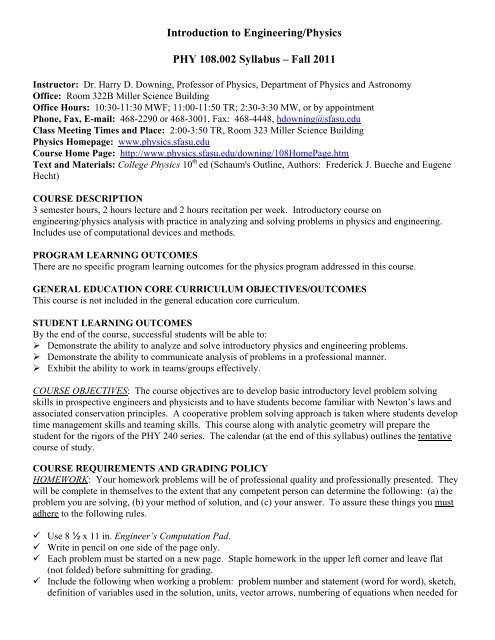

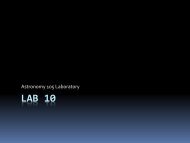
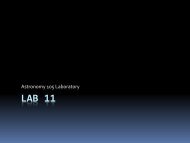
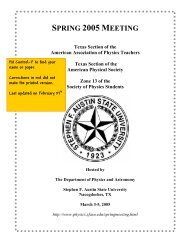
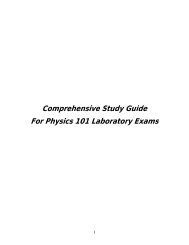

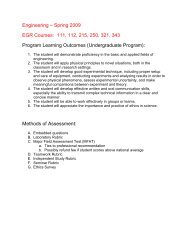
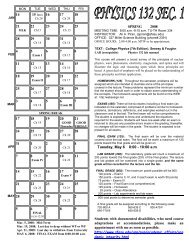
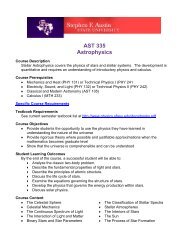

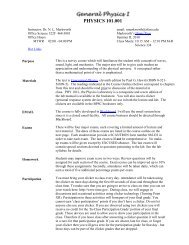
![[pdf] physics 110 fundamentals of electronics](https://img.yumpu.com/29312006/1/190x245/pdf-physics-110-fundamentals-of-electronics.jpg?quality=85)
